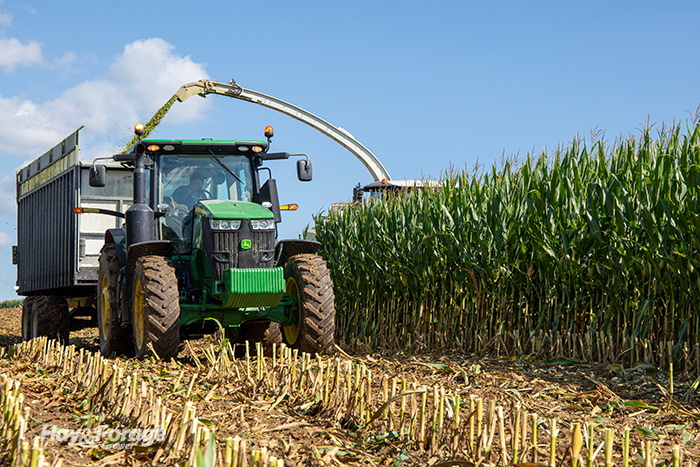
Best practices for corn silage harvest and storage are repeated in many articles, webinars, podcasts, and other sources of media this time of year. It may seem like preaching to the choir, but those plant moisture targets, machinery maintenance tips, chop length and particle size suggestions, and rules of thumb for packing forage can really make the difference between a good-quality crop and a bad one.
The compass of forage quality only points south as soon as plants are cut, so every step between chopping corn and sealing the storage pile is essential to preserve the nutrients captured at harvest. In the case of foliar disease, however, silage quality and dry matter content can start to decline while forage is still in the field.
In last month’s Hoard’s Dairyman webinar, John Goeser with Rock River Laboratory Inc. and Cows Agree Consulting stated that for foliar disease to occur, the three points of the disease triangle must intersect: favorable weather, a virulent pathogen, and a susceptible host. As of the recording, the first two factors were apparent in many Midwestern fields with an excessively wet growing season and evidence of corn disease in previous years. The third factor was to be determined prior to pollination and ear fill.
Last week, Goeser and Damon Smith with the University of Wisconsin-Madison released a statement to alert farmers of an uptick in reports for stalk and ear rot across America’s Dairyland. With the potential for greater development of foliar disease, they encourage farmers to proactively scout fields ahead of silage harvest.
Late-season foliar disease likely won’t affect corn grain yields; however, it can negatively affect forage moisture, and therefore, silage quality. Foliar disease desiccates plant leaves, causing dry matter losses in standing corn, especially when it comes to tar spot. This hastened dry down shortens the harvest window and produces a product that is more challenging to ensile than a healthy crop. Diseases can also have reverberating effects on feed hygiene when mycotoxin-producing fungi have access to oxygen in storage.
Look at late plantings
In a recent Badger Crop Doc article, Smith says corn that was planted on time and avoided flooding issues earlier this summer appears to be in good condition throughout Wisconsin. Late-planted corn may be more susceptible to a handful of diseases heading into the fall, including southern rust, gray leaf spot, northern corn leaf blight, and possibly tar spot.
“Not only do these diseases lead to a reduction in overall silage quality, but they can force the plant to scavenge for carbohydrates in the stalk, which can result in standability issues and lodging,” the extension field crop pathologist writes.
In addition to planting time, other factors that may help or hinder disease resistance include fungicide application and hybrid selection. Foliar disease could also be attributed to regional weather conditions. According to Goeser and Smith, southern and central Wisconsin are currently experiencing more disease pressure than the eastern part of the Badger State.
The threat of foliar disease in corn is not exclusive to Wisconsin, though. Agronomists and plant pathologists from Minnesota, South Dakota, and New York agree there is growing concern in cornfields across their respective states. Although disease pressure will vary from farm to farm and isn’t expected to be a wide-spread phenomenon, it is still prudent to consider the impact it can have on corn silage harvest and storage.
Get ahead of the spread
Goeser and Smith assert the first step to outcompete quality losses is to chop corn early. Foliar disease accelerates dry down, so starting harvest sooner than later can help optimize whole-plant moisture. The specialists recommend targeting 65% whole-plant moisture for corn silage in most systems.
Getting ahead of schedule will also stop the spread of disease to different parts of the plant. This is especially important before cool, wet weather sets in, which will expedite the movement of foliar disease up into the crop canopy, escalating the severity of a disease outbreak.
Start monitoring plant moisture now, and scout corn often. If whole-plant moisture drops below 55%, Goeser and Smith suggest storing this material in a separate bunker or pile. It will be harder to pack, and fermentation results may vary, making oxygen exclusion that much more critical to silage quality.
Goeser and Smith remind farmers to apply 800 to 1,000 pounds of tractor weight per ton of forage per hour as it is delivered to the storage site. Utilizing oxygen barrier films, covering silage in quality plastic, and ensuring tire coverage is sufficient across the entire pile are other best practices to implement for optimal silage fermentation.
Applying a research-backed inoculant or preservative can also help maintain forage quality at the time of packing, but these products will not make up for nutrients lost to poor storage practices.
The consequences of a sub-optimal fermentation go beyond lower forage quality at feedout. Goeser and Smith state that silage will be more susceptible to anaerobic instability, mold and yeast growth, and higher mycotoxin concentrations. The specialists also note some fungi, such as the Gibberella ear rot fungus, can produce mycotoxins like deoxynivalenol (DON) in stored forage if enough oxygen is available after packing.
Take samples and test silage for DON and other conjugates before ensiling. Smith notes levels will likely rise in affected forage during storage despite even the most efficient packing and sealing. Therefore, another forage analysis after fermentation will be necessary to assess mycotoxin concentrations before feeding silage to livestock.

